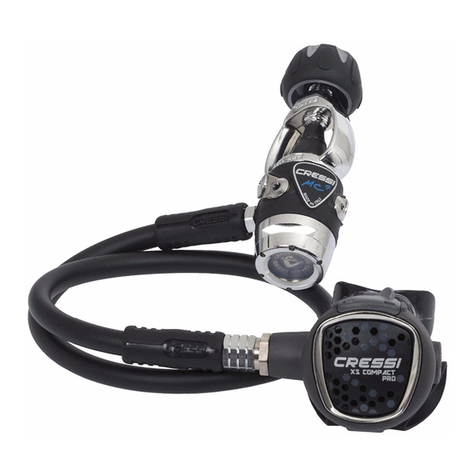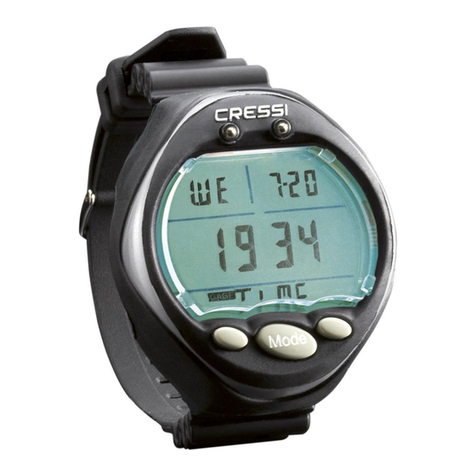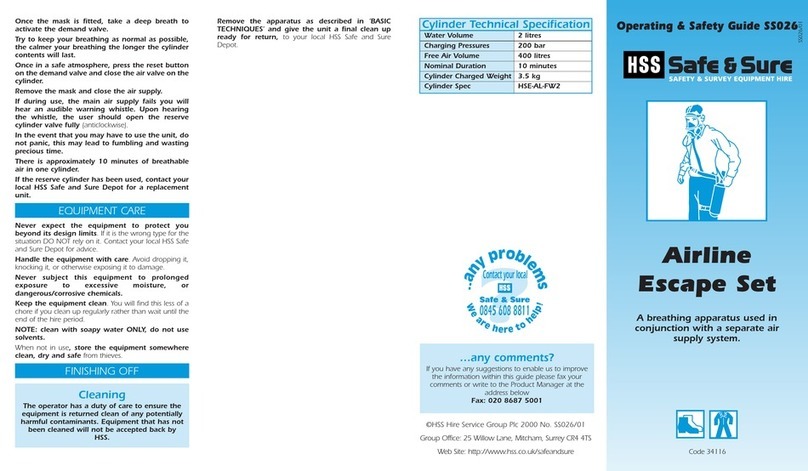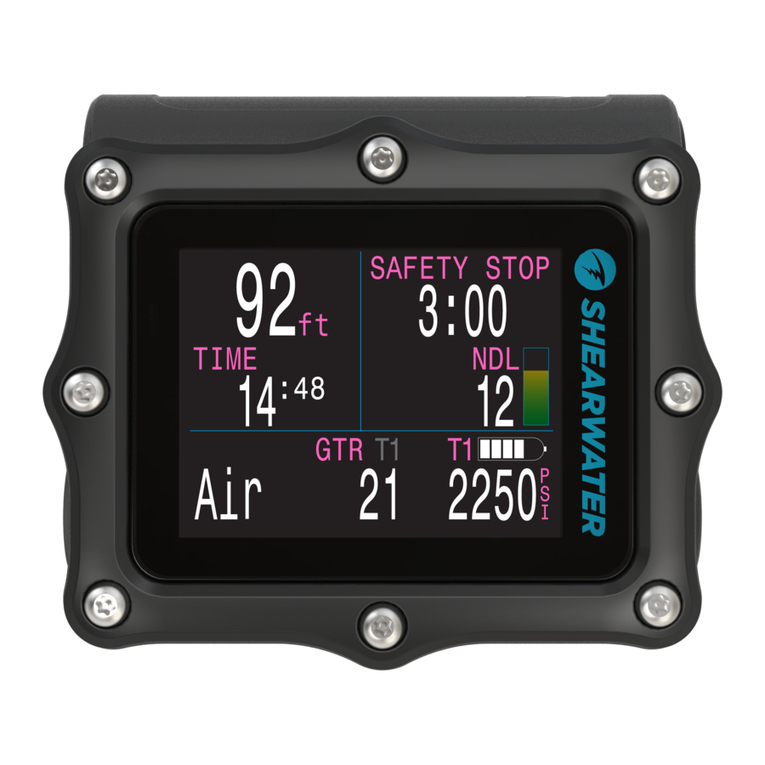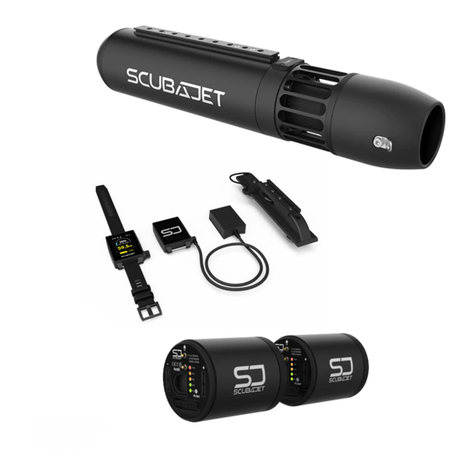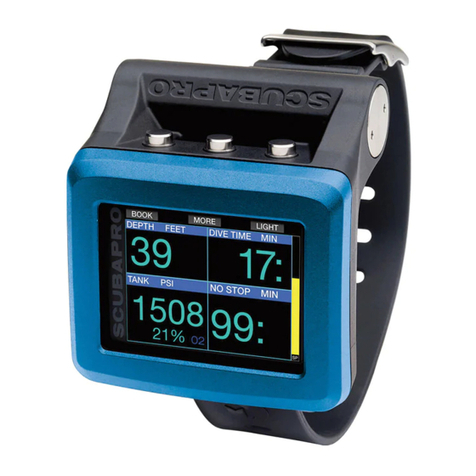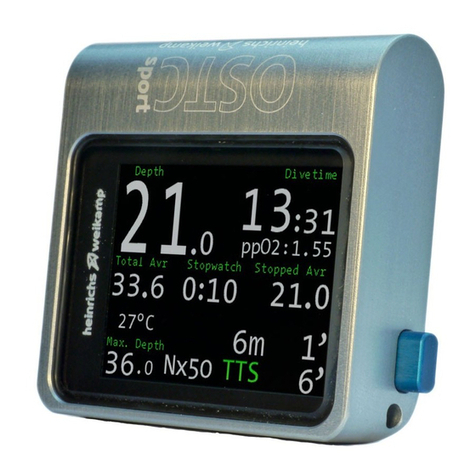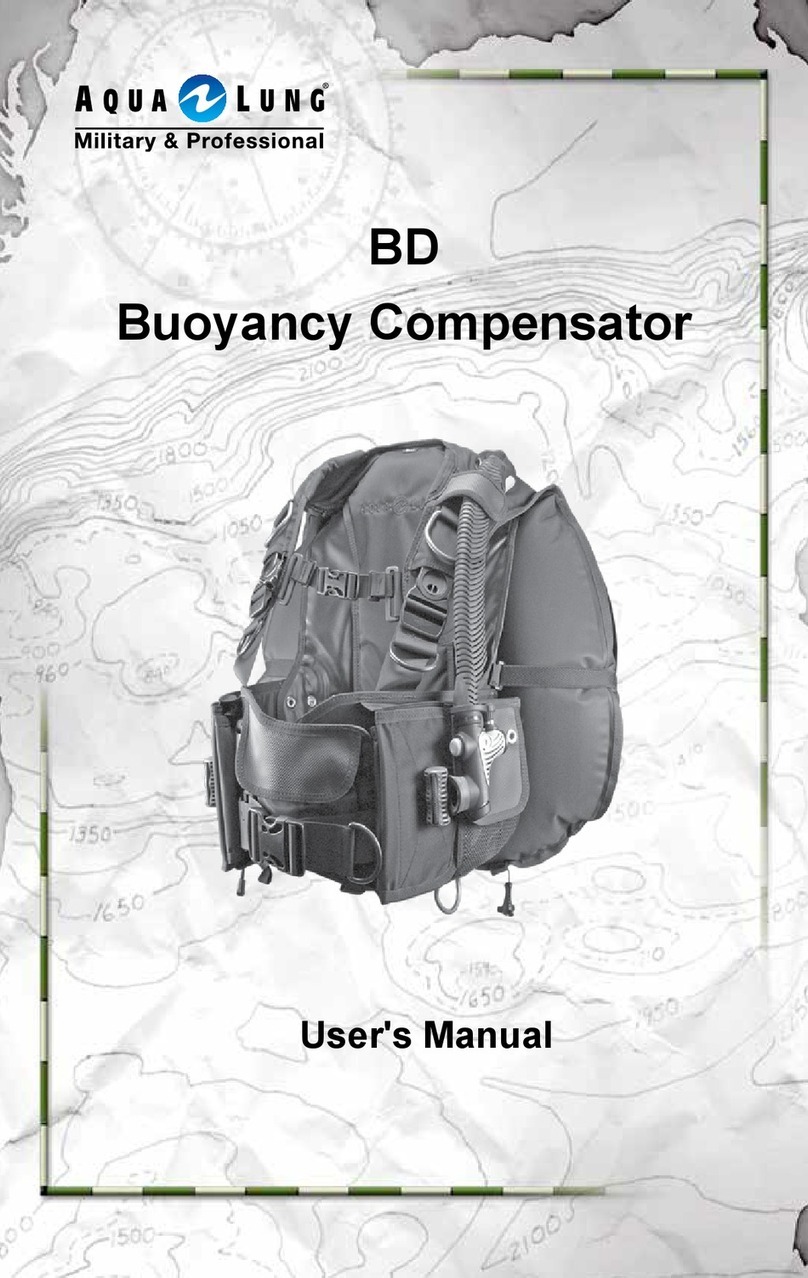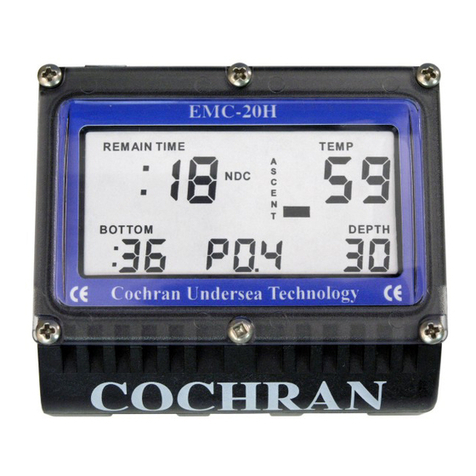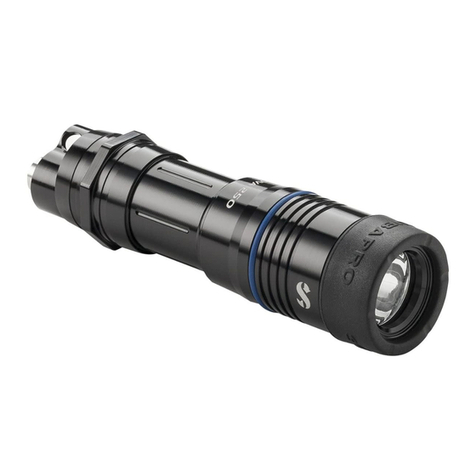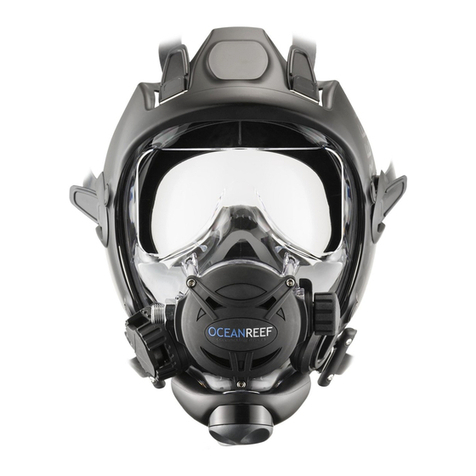Cressi DRAKE User manual

cressi.com
DRAKE
INSTRUCTION
MANUAL
cressi.com

cressi.com
TABLE OF CONTENTS
Main features - General instructions and safety standards. page 3
Introduction. page 4
Computer control - How the computer works - Clock function –
Chronograph page 5
SET TIME menu: Date and time adjustment - SWAP function:
Exchange of main time with secondary time. page 6
Alarm setting - Underwater computer activation. page 7
Underwater computer function. page 8
Selection of Free diving program - FREE program. page 9
PRO program. page 10
STATIC program. page 11
DYNAMIC program. page 12
Alarms and settings - Recommended Recovery Time alarm for
FREE and PRO programs. page 13
Surface, Depth and Diving time alarms for FREE and PRO
programs. page 14
Number of diving alarms for FREE and PRO programs,
setting of acoustic alarms and sea and fresh water. page 15
Automatic lighting and Depth to Step alarm for PRO program. page 16
Diving time and Surface time sum alarm for DYNAMIC program -
Surface Time alarm for STATIC and DYNAMIC programs. page 17
Diving time alarm for STATIC and DYNAMIC programs. page 18
Lap counter alarm for DYNAMIC program and Free diving counter
alarm for STATIC program.
Repetition counter for DYNAMIC AND STATIC programs. page 19
Repetitions with increases and decreases for STATIC and
DYNAMIC programs. pag. 20
Storage and import of alarms settings - Zero settings of alarms. page 21
LOG BOOK function. Dive log. page 22
HISTORY function. Dive history - PC LINK function,
PC compatible interface.
page 23
SYSTEM menu: Setting of unit of measure and sampling time. page 24
Care and Maintenance - Battery replacement -
Technical Specifications - Warranty. page 25
2

cressi.com
Congratulations on your purchase of Drake underwater watch computer, a sophisticated and complete
device which offers the utmost safety, efficiency and reliability in free diving. Always keep this manual with
your Cressi Drake.
Main features.
WATCH
- 12/24-hour time with minutes and seconds.
- Calendar.
- Precision chronograph with split time function and lap time.
- Function according to time.
- Possibility of changing between main and secondary time.
- Multi alarms.
UNDERWATER COMPUTER
- CRESSI DRAKE ESGM-G0015 interface system developed entirely in our laboratories and exclusively
for free diving.
- Specific advanced display.
- Four special complete programs for different diving disciplines:
FREE program: Processor of key data for deep free diving. PRO program: Processor of advanced and
complete data for deep free diving. Extension RRT RECOMMENDED RECOVERY TIME and TR TIME
RATIO to FREE and PRO programs for total safety during the sessions of deep diving.
DYNAMIC program: Complete processor of data for diving in dynamic free diving. STATIC program:
Complete processor of data for diving in static free diving.
- Extension REPS to STATIC and DYNAMIC programs to create and store regular and incremental
training tables.
- Complete setting of alarm parameters of time, depth and the number of diving or laps.
- Possibility of storing 36 settings of alarms.
- Possibility of loading different alarm settings.
- Possibility of immediate zero setting of alarms.
- Acoustic and visual alarms.
- Acoustic alarms activated and deactivated.
- Possibility of self-lighting of the display in depth.
- Sea and fresh water setting.
- Battery replacement carried out by the user.
- Logbook of sessions.
- Three functions of Dive history: static diving, dynamic diving and deep diving.
- Possibility of setting the sampling time.
- Unit of measure change from the metric system (meters and °C) to the feet system (ft- °F) by the user.
- PC/Mac interface with general data and dive profile (optional).
GENERAL INSTRUCTIONS AND SAFETY STANDARDS.
IMPORTANT: It is important to read the instructions for safety reasons and to learn how to use this device
in the best way. Carefully read this user manual, including the safety measures sections. Make sure you
perfectly understand the use, functions and limits of the device before using it! DO NOT use the device
without having read every part of this instructions booklet
IMPORTANT: The safety of free diving depends on the rational capacity of each of us to develop the
theoretical and practical knowledge with common sense and prudence in order to avoid accidents. This
device must therefore only be considered an aid to free diving for people carefully prepared to the risks this
activity entails. It must be used then, only and exclusively, when you have a complete theoretical and
practical training on the techniques of free diving and its dangers.
DANGER: NO UNDERWATER COMPUTER IS ABLE TO PREVENT ANY RISK OF SYNCOPE OR THE
TARAVANA SYNDROME. IT MUST BE WELL CLEAR THAT AN UNDERWATER COMPUTER CANNOT
AND HAS NO INTENTION TO REDUCE THE RISK OF SYNCOPE OR THE TARAVANA SYNDROME.
THE COMPUTER, IN FACT, SIMPLY INDICATES THE DIVING AND SURFACE TIME, THE DEPTH AND
THE RELATIONSHIP BETWEEN THEM. THE INFORMATION THAT IS PROVIDED BY THE
UNDERWATER COMPUTER IS SIMPLE DATA THAT BECOME SAFETY INFORMATION ONLY AND
EXCLUSIVELY ONCE EXAMINED AND PROCESSED BY THE HUMAN MIND. SO IT IS
RECOMMENDED TO CARRY OUT A SOLID AND DEEP THEORETICAL PREPARATION.
IMPORTANT: This device must be used only by certified divers: no computer can, in fact, replace proper
underwater training. Please remember that a diving safety is only guaranteed by a correct preparation.
IMPORTANT: Drake computer by Cressi is designed for sport diving only and not for
professional use.
IMPORTANT: Before using the computer, please check the battery life status and the indications on the
display. DO NOT dive if these indications are not perfectly clear and, especially, if the battery is low.
IMPORTANT: Do not go into the water if the glass has cracks, chips or other. If the computer has been hit
in the glass area, or the edges of it, it is recommended not to enter into the water and take it to a CRESSI
authorised service centre to check the sealing.
DANGER: Before and air travel or altitude travel it is important not to perform heavy diving sessions at a
fast pace in the past 48 hours.
IMPORTANT: Before diving, check the device parameter settings.
IMPORTANT: Deep diving is a risky discipline and must be practice safely with a lot of practical and
theoretical training. It is therefore important to obtain a patent at a certified diving school. It is
recommended to be fully aware of its limitations and to practice this discipline within them. It is
recommended to never dive alone and always be followed by a partner ready to intervene if necessary.
IMPORTANT: Currently, there is no validated scientific literature that tells perfectly the causes of Taravana
syndrome. It is therefore important for your health not to dive in deep diving with a rapid pace for several
hours associated with short surface intervals, not to immerse in health conditions that are not perfectly
regular and always to remain hydrated and with a regular supply of energy.
REMARK: in case of air travel, the device must be stored in the pressurised cabin.
As a result of technological advancements, Cressi reserves the right to modify the device without prior
notification.
3

cressi.com
Introduction.
The watch computer Drake by Cressi is a recreational advanced tool. It will provide all the necessary
information as regards depth, dive times, possible need of decompression, descent and ascent rate and all
the surface intervals between dives. It also provides average data for each session and a separate and
special counter instantly shows the relationship between surface time and diving time. This information is
shown on the device's special display that allows an easy and direct "dialogue" between the diver and the
computer, ensuring a clear understanding of all the data needed at any given time and a perfect readability
in any situation. The computer is provided with clock, a chronograph and calendar and a versatile dive
memory (logbook). Drake operating system allows the adoption of four specific programs dedicated to free
diving and its various functions. In fact, deep diving, to meet any needs, can be practised with the two
programs called FREE and PRO, the static diving has the STATIC program and the dynamic diving has the
DYNAMIC program. Additionally, the device may be set by the user for either metric (m-ºC) or feet system
(ft- ºF). The Drake underwater watch computer can be connected to a personal computer by means of the
Cressi interface (accessory) and the related software (accessory). It is very important to carefully read this
user manual and to perfectly understand the meaning, otherwise serious damage can be caused to your
health. This manual is intended to guide the user to comprehend all the functions of the computer before
using it in diving. The Drake watch computer by Cressi is always on in the watch function and to pass to
underwater computer press and hold the MODE push-buttons or slide to DIVE menu. In the underwater
computer function, the display shows the PRE DIVE mode and the different functions are always set by
means of the push-buttons, as seen below.
In order to understand all the computer's functions and their meaning, the manual is divided into six main
chapters, dealing with every possible use:
1 - General instructions and safety standards 2 - Computer control
3 - Programs
4 - Alarms and settings
5 - Logbook and System
6 - Care and maintenance
4

cressi.com
COMPUTER CONTROL
HOW THE DRAKE WATCH COMPUTER WORKS - CLOCK
FUNCTION
Drake has a very intuitive display, which "accompanies" the diver during any operation and four push-
buttons with which it is possible to control the device: two upper (LIGHT and MODE) and two lower (UP
and DOWN).
PUSH-BUTTONS FUNCTIONS
Each push-button has a precise function which is described below.
LIGHT push-button: This push-button is used to light the display to quickly pass the programs FREE and
PRO or vice versa, and to turn off the device.
MODE push-button: This push-button is used to enter into the different menus or to confirm any
information. Pressing can be short or long. In the clock function, long pressing of 4 seconds allows
accessing to the underwater computer.
UP push-button: This push-button is used to scroll through the different menus and to set adjustments in
ascending order.
DOWN push-button: This push-button is used to scroll through the menu and to set adjustments in
descending order.
The displays that characterise the clock function are five:
- The first shows a time indication in the central area.
- The second one, besides the main time, shows the secondary time in the lower area. The date in the left
upper area and the seconds in the right upper area.
- The third one is the CHRONO display: Indicating that from this menu, it is possible to access to the
chronograph.
- The fourth one is the SET TIME display: Indicating that from this menu it is possible to access to the
adjustment of time, the secondary time, alarm, date and 12/24 hour. In this menu with the SWAP function,
it is also possible to exchange the main time with the secondary time zone and vice versa.
- The fifth one is the DIVE display: Indicating that from this menu it is possible to access the underwater
computer.
TURNING OFF THE DEVICE
To reduce battery consumption when not in use, Drake can be turned off by pressing the LIGHT push-
button for 5 seconds. Switching off will cause the loss of TIME and DATE.
CHRONOGRAPH
To access the chronograph press the UP or DOWN push-button up to the CHRONO menu down in the
display, then press MODE. CHRONO disappear to give way to the counter. To activate the chronograph,
press the UP push-button.
If split times are necessary, press the DOWN push-button (upper left, the message L1,2, ... 20 appears
and the chronograph time will indicate the split time for three seconds and then go back to counting). It is
possible to store up to 20 split times. While the chronograph is activated, at the upper right, the "LAP
TIME" will be also activated that detects the time between a split time and the other. It starts from zero
every time the split time DOWN push-button is pressed. Stop counting by pressing the UP push-button (the
message stop appears at the upper left). The split times will be displayed by pressing the DOWN push-
button. Zero setting is carried out by pressing and holding the UP push-button. To exit the CHRONO
function simply hold the MODE push-button for a few seconds until the acoustic signal.
DRAKE WATCH DISPLAY
DRAKE WATCH BUTTONS
CHRONO
UP
DOWN
MODE
LIGHT
UP push-button: This push-button is used
to scroll through the different menus and
to set adjustments in ascending order.
Mode push-button: This push-button
pressed for a short time it is used to enter
into the different menus. If pressed for a
long time, in any position, it is used to exit
the different menus and change to the
clock. In the CLOCK function, long
pressing during 4 seconds to access to
the underwater computer. In the SET TIME
function, short pressing in some cases to
confirm the data set.
DOWN push-button: This push-
button is used to scroll through the
menu and to set adjustments in
descending order.
LIGHT push-button: This push-
buttonis used to light the display,to
quickly pass from FREE and
PROprograms or vice versa, and to
turn off the device.
5
TIME DISPLAY SET TIME DISPLAY DIVE DISPLAYCHRONO DISPLAY
TIME DISPLAY + SECONDS
+ DATE + DUAL TIME
CHRONO DISPLAY READY CHRONO CHRONO ON CHRONO SPLIT TIME
3’’ BEFORE CHRONO SPLIT TIME CHRONO STOP CHRONO SPLIT TIME 1 CHRONO SPLIT TIME 2...20
CHRONO RESET
LONG

cressi.com
MENU SET TIME
Date and time adjustment.
Press the UP button until you see TIME SET mode on the display, then press the Mode button. The digits
of the time (t1) start flashing in the lower part of the dial. Press the UP or DOWN button to pass to the
indicators of minutes, of the secondary time (t2), of the alarm (AL), of the year, month, day and the setting
of 12/24 hours. Scroll up to the desired setting and press the Mode button. The display shows just the
highlighted item, flashing. Change it by pressing the UP or DOWN button. Confirm the value set by
keeping the Mode button pressed for a few seconds until hearing an acoustic signal to confirm exit from
the menu. Keep pressing and holding the Mode button to return to the main menu (after another acoustic
signal) Alternatively, after the last time the buttons are pressed, the computer will modify the automatic
setting by issuing an acoustic signal to return then to the main screen, and then it will automatically shut
down.
REMARK: To store exact information in the computer logbook, remember to check for correct time and
data settings.
SWAP function: swap the main time T1 with the secondary time T2.
When travelling, it is necessary to store data of the computer using the time zone of the place but at the
same time it is possible to also see the time at the place of origin. This need is strongly felt especially by
those who go several times to the same foreign country.
The SWAP function allows the exchange of times T1 (main) and T2 (secondary) so the computer records
our dives in the foreign time and at the same time it is possible to keep aware of our time of origin.
To activate this function, press the UP button until "T1" or "T2" flash, and then press the Mode button.
"SWAP" will appear on the display to confirm that the time has been changed. Hold down the Mode button
for a few seconds until hearing an acoustic signal to confirm the exit from the menu. Keep pressing and
holding the Mode button to return to the main menu (after another acoustic signal) Alternatively, after the
last time the buttons are pressed, the computer will modify the automatic setting by issuing an acoustic
signal to return then to the main screen, and then it will automatically shut down.
6
SET TIME: TIME 1
SET TIME: TIME 2
AUTOMATIC
RETURN OR
WITH LONG
MODE BUTTON
BEEP
AUTOMATIC
RETURN OR
WITH LONG
MODE BUTTON
BEEP
AUTOMATIC
RETURN OR
WITH LONG
MODE BUTTON
BEEP
SET TIME: SWAP TIME 1 WITH TIME 2
AUTOMATIC
RETURN OR
WITH LONG
MODE BUTTON
BEEP
AUTOMATIC
RETURN OR
WITH LONG
MODE BUTTON
BEEP

cressi.com
Alarms setting.
To set the alarm type in the Set Time menu once the alarm time has been reached it is necessary to
continue pressing the Up button until the "AL" stops flashing. Now press the MODE button. The alarm
mode set will appear. Press the UP or DOWN button to change modes. The alarm mode will be as follows:
Daily: To make sure that the alarm sounds each day.
Once: To make sure that the alarm sounds once only. Off: The alarm is switched off.
UNDERWATER COMPUTER ACTIVATION
Access to the underwater computer from the watch function can occur in two ways. The first is just a long
press on the MODE button and then the message DIVE appears on the display and then after releasing it,
the PRE DIVE screen of the set program (Free, Pro, Dynamic and Static). In the second mode, it is
necessary to scroll through the menu with the UP or DOWN button until the DIVE menu and then press the
MODE button. DIVE will appear on the display and then immediately the PRE DIVE screen of the set
program (Free, Pro, Dynamic and Static).
WARNING: When diving, Drake does not automatically switch from watch function to underwater
computer function and then, before entering the water, it is recommended to activate it manually. If
you were already immersed, activate it by holding it for a moment out of the water.
ACCESS TO DIVE COMPUTER
1:
2:
TIME DISPLAY
LONG
TIME DISPLAY
TIME DISPLAY
AFTER 2’’
AFTER 4’’
ALARM SET
SET TIME DISPLAY
7

cressi.com
UNDERWATER COMPUTER FUNCTION
As we said to access the underwater computer when Drake is in the watch function, press and hold the
MODE button or scroll until the DIVE menu with UP or DOWN buttons, then press the MODE button. The
screen of the PRE DIVE function appears. This screen will show time and depth counters, the current time
and the following icons may appear:
- Watch icon indicating that the neighbouring numbers refer to the time.
- Bell icon indicating that the audible alarms are activated.
- Sea water or fresh water icon.
- Icon of alarm indication with STEP if the function is active.
- Lamp icon to indicate the automatic lighting of the display in depth if the function is active.
WARNING: The underwater computer is not activated automatically and it is necessary to activate it
manually before diving. The manual activation is always possible even after a few dives, but must
also be performed out of the water. Otherwise there will be a systematic error on the depth
measurement.
During the PRE DIVE function, the screen is lighted by pressing the LIGHT button.
Then press the UP button to scroll and advance the main menu, which shows, in succession, 7 sub menus
of the screen:
1) LOG-00: It is the record of the dives (Logbook) of the device and the number following the "LOG"
message indicates the number of the last session.
2) MODE-S: It allows choosing the free diving mode that you want. The computer has four modes: FREE,
PRO, DYNAMIC and STATIC.
3) ALARMS: The ALARMS menu allows setting different alarms and functions.
4) PCLINK: It allows the connection and interfacing of Drake to a personal computer.
5) HISTORY: In this menu, the historical memory of dives performed is highlighted.
6) SYSTEM: In the System menu, it is possible to set the unit of measurement of the computer and the
sampling frequency.
7) PRE DIVE: It is the screen that anticipates our dives and appears after entering the underwater
computer function or after setting the alarms and adjustments.
To access the sub menus (excluding history and pclink), press the Mode button. Then, press the
UP button to move forward and press the DOWN button to move backward in the menu by scrolling
through the data contained in it. To exit, just press and hold the Mode button or wait until Drake
computer returns to the previous menu screen automatically. Return to the watch function is
performed automatically or by pressing during some seconds the Mode button until you hear the
confirmation acoustic signal.
Find below the explanation of all the operations available for each menu of the display.
FREE PRE DIVE DISPLAY
DYNAMIC PRE DIVE DISPLAY
DIVE COMPUTER MENU
8
LONG
UP
DOWN
MODE
LIGHT
PRO PRE DIVE DISPLAY
STATIC PRE DIVE DISPLAY
Last session
data (dive-run counter
+ total time)
From different
computer mode
(pro, free, dinamic)
READY TO DIVEREADY TO DIVE
PRE-DIVE

cressi.com
CHOOSE DESIRED COMPUTER MODE FOR FREE DIVE
SELECTION OF SPECIFIC FREE DIVING PROGRAM.
Drake, as we said, has 4 pre-set programs suitable to the main disciplines of free diving. To set the desired
program, it is necessary to access to the underwater computer (during access you will notice at the bottom
of the display the program set at the time) and once in the pre-dive screen scroll with UP or DOWN buttons
until the MODE-S menu. Press the MODE button. The program set at that time will appear at the bottom of
the display. Subsequently, press the UP or DOWN buttons to scroll through the other programs. Once you
reach the one you want, confirm it by holding down the Mode button for a few seconds until hearing an
acoustic signal confirming the exit out of the menu. Continue pressing and holding the Mode button to
return to the watch function (after another acoustic signal). Alternatively, after the last time the buttons are
pressed, the computer will modify the automatic setting by issuing an acoustic signal to return then to the
main screen, and then it will automatically shut down.
NB: Drake is set by default with the FREE program and alarms off.
FREE PROGRAM.
This program has been designed to provide the main data necessary for deep diving. Its special display
shows in the central part the most important data of that moment, alternating the depth (during the dive)
and the recovery time (as soon as it is on the surface). Its peculiarity is that is easy to use and the visibility
of the important data which are always in the centre of the display. It is a program designed for those
dedicated to free diving without the need to conduct a comprehensive analysis of its performance. Very
suitable for underwater fishermen. Perfect for snorkelling and for those who practice intensively the
discipline of sea-running or advanced snorkelling where you swim along the coast intensely alternating
dives of deep diving.
When the FREE program is set on the display, the following information appears:
On surface.
- At the top left of the display: Maximum depth reached during the last dive.
- At the top right: During the last dive.
- At the centre: Surface or recovery time.
- By scrolling with the UP or DOWN buttons down in succession: time, number of diving and minimum
water temperature, Recommended Recovery Time (recovery time calculated based on the TR-Time Ratio
pre-set by the user).
When diving.
- At the top left: Maximum depth reached.
- At the top right: Diving time.
- At the centre: Current depth.
Always visible:
- Sea water or fresh water setting icon.
- Acoustic alarms icon activated.
If you want to have more information about your dives, once you set the FREE program you can
immediately access "on-fly" to the PRO program simply by pressing the LIGHT button for a few seconds
(see PRO program).
How to use the FREE program.
Once in the program just dive and Drake will automatically display the data andwill start various counts. So
it will be for the entire session of deep diving. On the surface to displaythe information available just press
the UP or DOWN button. In the case of passage to programs STATIC or DYNAMIC Drake will close the
current session.
FREE MODE DURING FREE DIVE SESSION
DIVE SURFACE
PRE-DIVE SURFACE SURFACE
DIVE NUMBER
TEMPERATURE
TIME RRT: RECOMENDED
RECOVERY TIME
DIVE DISPLAY
1:
2:
LONG
TIME DISPLAY
AUTOMATIC
RETURN OR
WITH LONG
MODE BUTTON
BEEP
AUTOMATIC
RETURN OR
WITH LONG
MODE BUTTON
BEEP
9

cressi.com
PRO PROGRAM.
Program for deep diving very advanced and complete that analyses in detail the performance of the diver
while providing useful information for his safety. In fact, a special indicator called Time Ratio TR constantly
scans the diving time and the recovery time providing instantly the relationship between them, relatively at
the last dive carried out and relatively at the average dives and recoveries of the session in place (since
the start of the day until that moment). All this is to inform the diver in detail about one of the most mportant
causes of the Taravana syndrome and so the too low relationship between the recovery time and the diving
time. With this important indication, the diver will have the possibility to carry out the subsequent dive once
the Time Ratio TR indicates a value which he considers safe. The display shows the data main in static
screens so as to facilitate the reading of large amount of information available. In the bottom, it is possible
to scroll through the secondary data and leave the most appropriate to the type of performance carrying
out. It is an ideal program for the advanced diver who makes deep dives and wants to improve his
performance for competitive purpose. It is also indicated for deep underwater fishing.
When the PRO program is set, the following information appears on the display:
On surface.
- At the top left: Instant Time Ratio (relationship between surface time and the duration of previous diving)
- At the top right: Surface or recovery time.
- At the centre: Maximum depth and duration of last diving.
Scrolling with UP or DOWN buttons downward: time, number of diving and minimum water temperature,
Recommended Recovery Time (recovery time calculated based on the TR-Time Ratio pre-set by the user),
descent time, ascent time, average descent speed, average ascent speed, total average speed.
- Scrolling with UP or DOWN buttons at the centre: total diving time and total surface time.
- Scrolling with UP or DOWN buttons in the complete display: average data (from top left: average time
ratio, average recovery time, average depth, average diving time, dives per hour)
When diving.
- At left centre: Current depth.
- At right centre: Diving time. Pressing the UP or DOWN buttons:
- At the top left: Maximum depth reached.
- At the bottom, during descent: Average descent speed.
- At the bottom, during ascent: Average ascent speed (by detachment from the bottom)
Always visible:
- Sea water or fresh water setting icon.
- Acoustic alarms icon activated.
- Icon of STEP alarms set.
- Icon of self-illumination set.
If you want to change the screen of the PRO program to FREE, you can immediately access "on-fly"
simply by pressing the LIGHT button for a few seconds.
How to use the PRO program.
Once in the program just dive and Drake will automatically display the data and
will start various counts. So it will be for the entire session of deep diving. On the surface to display the
information available just press the UP or DOWN button. In the case of passage to programs STATIC or
DYNAMIC Drake will close the current session.
WARNING: Before using the Drake underwater computer, it is recommended to take a diving
course at a serious and accredited school.
WARNING: Diving is an underwater discipline that definitely is not as simple as it might seem.
Before you engage in this activity you must know in depth all the physiological, physical and
chemical aspects. It is also fundamental that you have a deep knowledge of the underwater
medical point of view.
SURFACE SURFACESURFACE DIVE NUMBER +
TEMPERATURE TIME
SURFACE
RECOMMENDED RECOVERY
TIME + TEMPERATURE
DESCENT + ASCENT
SPEED
SURFACE SURFACESURFACE SURFACE
DESCENT SPEED
DESCENT TIME ASCENT TIME
SURFACE SURFACE
TOTAL DIVE TIME TOTAL SURFACE TIME
SURFACE
AVERAGE DATA
SURFACE
ASCENT SPEED
DIVEPRE-DIVE DIVE
DESCENT SPEED ASCENT SPEED
PRO MODE DURING FREE DIVE SESSION
10
FREE-PRO SWAP MODE
FREE MODE FREE MODEPRO MODE
LONG LONG

cressi.com
DIVEREADY TO DIVE
READY TO DIVE
SURFACE SURFACE
SURFACE SURFACE SURFACE
MANUAL
ON
MANUAL
STOP
SURFACE
PRE-DIVE PRE-DIVE
STATIC MODE DURING FREE DIVE SESSION
DIVE NUMBER
TEMPERATURE
TIME LAST TIME CHRONO RESET RESET
FROM DIFFERENT
COMPUTER MODE
(PRO, FREE, STATIC)
STATIC PROGRAM.
Program for static diving dedicated to athletes who want to practice the discipline or those who
just want to train to improve their performance. Its special display shows in the central part the most
important information at that moment, alternating the diving time to the recovery time. It must be operated
manually as a standard depth is not defined for which it is considered a static diving. Some athletes are on
the water's surface while others are just a few centimetres deep. It is therefore necessary to manually
activate the chronometer at the beginning of the diving and stop it at the end so that the computer starts to
count the recovery time. The display also shows the depth. In the bottom, it is possible to scroll through the
secondary data and leave the one you want.
When the STATIC program is set, the display shows the following information:
On surface.
- At the top right: Time of last diving.
- At the top left: Current depth.
- At the centre: Surface or recovery time.
- Scrolling with UP or DOWN buttons at bottom: number of diving and water temperature, time, last
chronograph information and reset to restart and carry out a new session.
When diving.
- At the top left: Current depth.
- At the centre: diving time
- At the bottom: chronograph for the diaphragmatic contractions.
Always visible:
- Acoustic alarms icon activated.
- REPS icon activated.
How to use the STATIC program.
Once in the program, it must be operated manually by pressing the Mode button at the beginning of the
diving. After diving, and when re-emerging, to stop the time, press again the Mode button. The computer
will start to count the recovery or surface time until you press again the MODE button for subsequent
diving. Then, the time of the second diving will be counted. So on the times you want. To stop the computer
counting and start a new session, press the UP button repeatedly until the word RESET appears at the
bottom of the display. Press MODE and the computer will reset.
During diving Drake is able to measure the time, in minutes and seconds, from different times to the total
time of diving, such as the time between the diaphragmatic contractions.
WARNING: Before using the Drake underwater computer, it is recommended to take a diving
course at a serious and accredited school.
WARNING: Diving is an underwater discipline that definitely is not as simple as it might seem.
Before you engage in this activity you must know in depth all the physiological, physical and
chemical aspects. It is also fundamental that you have a deep knowledge of the underwater
medical point of view. DANGER: Before performing the test of static diving, make sure to be
followed by a person on the edge of the tank who is ready to intervene in case of need. It is also
recommended, during diving, to move a limb or a finger to ensure that the surface mate becomes
immediately aware of a possible loss of consciousness.
DIVE DIVE DIVE DIVE
DIVE TIME + CHRONO READY DIVE TIME + CHRONO ON DIVE TIME + CHRONO STOP DIVE TIME + CHRONO RE-ON
MANUAL
ON
11

cressi.com
PRE-DIVE PRE-DIVE
Last session
data (dive-run counter
+ total time)
DIVE
SURFACE SURFACE
SURFACE
SURFACE
DIVE-RUN
COUNTER
TOTAL TIME
TRAINING
SURFACE
TIME
DIVE
TIME
READY TO
DIVE
RESETTIME
DYNAMIC MODE DURING FREE DIVE SESSION
DYNAMIC PROGRAM.
Program dedicated to athletes who practice dynamic diving as a discipline or as training activities for the
improvement of their general performance. It is very suitable even for the sea-running or advanced
snorkelling where they swim along the coast intensely alternating dives of deep diving or not. Once in the
program, in order to operate the chronographs just dive to make the first tank diving.
When the DYNAMIC program is set, the display shows the following information:
On surface and during diving:
- At the top left: Sum of the diving time and surface time.
- At the top right: Surface time.
- At left centre: lap counters / path counters.
- At right centre: diving time.
- Scrolling with UP or DOWN buttons downward: total training and session time, time and reset function.
Always visible:
- Sea water or fresh water setting icon.
- Acoustic alarms icon activated.
How to use the DYNAMIC program
Once in the DYNAMIC program, Drake will start counting automatically as soon as you dive to make the
first tank diving. The diving time will be immediately displayed. Subsequently, as soon re-emerged, it will
count the surface time and the sum of both the times. And so on until you decide to stop or change the
session. To stop the computer counting and start a new session, press the UP button repeatedly until the
word RESET appears at the bottom of the display. Press MODE and the computer will reset.
WARNING: Before using the Drake underwater computer, it is recommended to take a diving
course at a serious and accredited school.
WARNING: Diving is an underwater discipline that is definitely not as simple as it might seem.
Before you engage in this activity you must know in depth all the physiological, physical and
chemical aspects. It is also fundamental that you have a deep knowledge of the underwater
medical point of view.
DIVE TIME
+
SURFACE TIME
12

cressi.com
ALARMS AND SETTINGS
Once in the underwater computer and after choosing the program suitable for your activity, it is possible to
set the alarms that can help the diver to perform the activity from the safety point of view and from that of
training or performance.
They can be visual or visual and acoustic depending on your needs.
Before describing each single alarm, we will indicate those available for each program.
FREE program alarms:
- RRT Recommended Recovery Time alarm.
- Surface time and recovery time alarm.
- Depth alarm.
- Diving time alarm.
- Number of dives performed alarm.
- Acoustic alarms setting.
- Sea or fresh water setting.
PRO program alarms:
- All the alarms of the FREE program.
- Depth to step alarm.
- Automatic lighting of the display.
STATIC program alarms:
- Surface time and recovery time alarm.
- Diving time alarm.
- Setting of repetitions to increase or rise the alarm times.
DYNAMIC program alarms:
- All the alarms of the STATIC program.
- Surface time plus diving time alarm.
- Number of laps covered alarm.
All the programs:
- Settings "save" function of alarms.
- Settings "loading" function of alarms from memory.
- Alarms reset or zero setting function.
WARNING: The alarms of the four programs of the Drake computer are completely separate and
independent.
WARNING: The alarms are off when bars instead of numbers appear. To disable the alarms of the times, it
is necessary to intervene on the minutes counter.
RECOMMENDED RECOVERY TIME ALARM FOR FREE AND PRO PROGRAMS.
Underwater diving, if not performed with proper preparation (both physical and theoretical) involves risks.
One of them is to incur in the neurological syndrome of TARAVANA
which is a particular form of Decompression Illness due to several factors associated with an accumulation
of nitrogen (This syndrome is still under study and its causes are not known exactly. It is therefore
recommended to deepen your knowledge by consulting updated and current texts of underwater
medicine). It is a disease that is known since the 40s and that affected the Polynesian pearl divers (the
term TARAVANA means madness). The cause can be summed up in an intense and excessive activity of
diving with duration of at least 4/5 hours, at great depths or in the range of -12/-18m and with very short
surface intervals. To avoid this syndrome, it is recommended to make surface intervals or recovery times
much longer than the diving times, to be perfectly hydrated and always provide an appropriate energy
recovery. To help the diver to keep a proper relationship between the diving time and the recovery time,
Drake has a special function that can store the multiplier of diving time (TR Time Ratio) desired by the
underwater and display the resulting recovery time that will be indicated by the acronym RRT
(Recommended Recovery Time). For example: if the diving time is 1' and 10" and the multiplier TR is
imposed in 4, the RRT time will be 4' and 40'' (1' 10" 'x 4 = 4' 40'').
Alarms setting.
To set the alarm scroll with UP or DOWN buttons until the ALARMS menu. Enter the menu by pressing
MODE. The numbers in the top left of the display below the TR indicator will flash. Press the MODE button
again. The display shows just the highlighted item, flashing. Set the desired value of the multiplier
(between 1.0 and 9.5 with variations of 0.5) by pressing the UP or DOWN buttons. Confirm the set value
by holding down the Mode button for a few seconds until hearing an acoustic signal to confirm exit from the
menu. Alternatively, the computer will change the settings automatically with an acoustic signal and then
13
ALARMS: RECOMMENDED RECOVERY TIME ALARM FOR FREE AND PRO MODE
AUTOMATIC
RETURN OR
WITH LONG
MODE BUTTON
BEEP
SURFACE PRO SURFACE FREE
RECOMMENDED RECOVERY
TIME
TEMPERATURE
RRT: RECOMENDED
RECOVERY TIME
will return to the main screen. Once the alarm has been set, the display will indicate with the word RRT the
time required for surface recovery. When the recovery time SURF.T reaches the RRT time, the diver is
notified visually by the flashing TR (in PRO mode) or flashing SURFT (in FREE mode) and, if the audible
alarms are set, also acoustically.

cressi.com
SURFACE TIME ALARM FOR FREE AND PRO PROGRAMS.
Drake also allows setting a simple alarm of surface time.
To set the alarm scroll with UP or DOWN buttons until the ALARMS menu. Enter the menu by pressing the
MODE button. The numbers in the top left of the display below the TR indicator will flash. Press the UP
button. The figure below the word SURF.T MAX will flash. Press the MODE button again. The display will
show only the highlighted information and the minutes indicator will flash. Set the desired value by pressing
the UP or DOWN buttons. Confirm the set value by pressing the Mode button until hearing an acoustic
signal of confirmation. The second figures will flash.
Set the desired value by pressing the UP or DOWN buttons. Confirm the set value by holding down the
Mode button for a few seconds until hearing an acoustic signal to confirm the exit from the menu.
Alternatively, after the last time the buttons are pressed, the computer will modify the automatic setting by
issuing an acoustic signal to return then to the main screen, and then it will automatically shut down.
Once the alarm has been set, the computer will signal any overcoming of time limit entered by flashing the
current surface time, accompanying it (if the audible alarms are set) with an audible alarm.
DEPTH ALARM FOR FREE AND PRO PROGRAMS.
To set the alarm scroll with UP or DOWN buttons until the ALARMS menu. Enter the menu by pressing the
MODE button. The numbers in the top left of the display below the TR indicator will flash. Press the UP or
DOWN buttons until the number below the word DIVE MAX m flashes.
Press the MODE button again. The display shows just the highlighted item, flashing.
Set the desired value by pressing the UP or DOWN buttons. Confirm the set value by holding down the
Mode button for a few seconds until hearing an acoustic signal to confirm the exit from the menu.
Alternatively, the computer will change the settings automatically with an acoustic signal and then will
return to the main screen.
If the PRO program has been set, we can set up to three depth alarms. As soon as you enter in the setting
of the depth value, the message DEPTH1 will appear. Confirm by pressing the MODE button. The
message DEPTH2 will appear. Set the desired value by pressing the UP or DOWN buttons. And so on up
to the third alarm. Confirm the values set by holding down the Mode button for a few seconds until hearing
an acoustic signal to confirm the exit from the menu. Alternatively, after the last time the buttons are
pressed, the computer will modify the automatic setting by issuing an acoustic signal to return then to the
main screen, and then it will automatically shut down.
Once the alarm has been set, the computer will show greater depth of the lower limit entered making them
flash and, if the audible alarms are set, issuing also an acoustic alert.
DIVING TIME ALARM FOR FREE AND PRO PROGRAMS.
To set the alarm scroll with UP or DOWN buttons until the ALARMS menu. Enter the menu by pressing the
MODE button. The numbers in the top left of the display below the indicator will flash TR. Press the UP or
DOWN button until digit below the letter T flashes. Press the MODE button again. The display will show
only the highlighted information and the minutes indicator will flash. Set the desired value by pressing the
UP or DOWN buttons. Confirm the set value by pressing the Mode button until hearing an acoustic signal
of confirmation. The second figures will flash. Set the desired value by pressing the UP or DOWN buttons.
Confirm the set value by holding down the Mode button for a few seconds until hearing an acoustic signal
to confirm the exit from the menu. Alternatively, after the last time the buttons are pressed, the computer
will modify the automatic setting by issuing an acoustic signal to return then to the main screen, and then it
will automatically shut down.
Once the alarm has been set, the computer will signal any overcoming of time limit entered by flashing the
current diving time, and if the audible alarms have been set, an acoustic signal will also sound.
ALARMS: SURFACE TIME ALARM FOR FREE AND PRO MODE
AUTOMATIC
RETURN OR
WITH LONG
MODE BUTTON
BEEP
ALARMS: DEPTH ALARM FOR FREE AND PRO MODE
AUTOMATIC
RETURN OR
WITH LONG
MODE BUTTON
BEEP
AUTOMATIC
RETURN OR
WITH LONG
MODE BUTTON
BEEP
- N.1 DEPTH
ALARM FOR
FREE MODE
- N.3 DEPTH
ALARMS FOR
PRO MODE
OR:
ALARMS: DIVE TIME ALARM FOR FREE AND PRO MODE
AUTOMATIC
RETURN OR
WITH LONG
MODE BUTTON
BEEP
14

cressi.com
NUMBER OF DIVING ALARM FOR FREE AND PRO PROGRAMS.
An alarm that alerts that a certain number of dives has been reached can be convenient for training
purposes or not to become tire.
To set the alarm scroll with UP or DOWN buttons until the ALARMS menu. Enter the menu by pressing the
MODE button. The numbers in the top left of the display below the TR indicator will flash. Press the UP or
DOWN button until the value at the bottom left of the display marked with the icon of the gate flashes.
Press the MODE button again. The display shows just the highlighted item, flashing. Set the desired value
by pressing the UP or DOWN buttons. Confirm the set value by holding down the Mode button for a few
seconds until hearing an acoustic signal to confirm the exit from the menu. Alternatively, after the last time
the buttons are pressed, the computer will modify the automatic setting by issuing an acoustic signal to
return then to the main screen, and then it will automatically shut down.
Once the alarm has been set, the computer will indicate that the number of dives inserted has been
reached by flashing the data related to dives performed, accompanying it (if the audible alarms are set)
with an audible alarm.
SETTING ACOUSTIC ALARMS FOR ALL THE PROGRAMS
There are diving disciplines where a sound alarm is necessary to keep higher concentration or where a
sound alarm can be more counter-productive than an aid. For these reasons, Drake allows the activation
or deactivation of the acoustic alarms according to the selected activity. Activating the acoustic alarms,
Drake will accompany each alarm previously entered with an audible signal. Otherwise Drake will eliminate
this acoustic signal to all active alarms in the current program.
To set the alarm scroll with UP or DOWN buttons until the ALARMS menu. Enter the menu by pressing the
MODE button. The numbers in the top left of the display below the TR indicator will flash. Press the UP or
DOWN button until the word BUZZ in the bottom right flashes. Press the MODE button again. The flashing
words ON or OFF will appear on the display. Change the words using the UP or DOWN button but
remember that in case of ON, the alarms will be activated while in case of OFF, the alarms will be
deactivated. Confirm the activation by holding down the Mode button for a few seconds until hearing an
acoustic signal to confirm the exit from the menu. Alternatively, after the last time the buttons are pressed,
the computer will modify the automatic setting by issuing an acoustic signal to return then to the main
screen, and then it will automatically shut down. The condition of the acoustic alarms is shown by the bell
icon that, in case of active acoustic alerts, will always be at the bottom of the display.
SETTING SEA WATER OR FRESH WATER FOR FREE AND PRO PROGRAMS.
Setting sea water or fresh water has a particular importance for an accurate and correct indication of the
depth. In fact, the density of the two types of water is not the same and this can cause discrepancies
between the actual depth and that indicated by the computer.
To set the type of water scroll with the UP or DOWN buttons until the ALARMS menu. Enter the menu by
pressing the MODE button. The numbers in the top left of the display below the TR indicator will flash.
Press the UP or DOWN button until the word SALT flashes on the bottom right.
Press the MODE button again. The flashing words ON or OFF will appear on the display. Change the word
using the UP or DOWN button but remember that in case of ON, sea water will be set while in case of OFF,
fresh water will be set. Confirm the activation by holding down the Mode button for a few seconds until
hearing an acoustic signal to confirm the exit from the menu. Alternatively, after the last time the buttons
are pressed, the computer will modify the automatic setting by issuing an acoustic signal to return then to
the main screen, and then it will automatically shut down.
ALARMS: NUMBER OF DIVING ALARM FOR FREE AND PRO PROGRAMS
AUTOMATIC
RETURN OR
WITH LONG
MODE BUTTON
BEEP
ALARMS: SETTING ACOUSTIC ALARMS FOR ALL THE PROGRAMS
AUTOMATIC
RETURN OR
WITH LONG
MODE BUTTON
BEEP
AUTOMATIC
RETURN OR
WITH LONG
MODE BUTTON
BEEP
SETTING SEA WATER OR FRESH WATER FOR FREE AND PRO PROGRAMS
15

cressi.com
SETTING AUTOMATIC LIGHTING FOR PRO PROGRAM.
Sometimes, when visibility is poor, it will be necessary to illuminate the display. Drake offers the possibility
to illuminate automatically after reaching a certain depth. To set the automatic lights scroll with UP or
DOWN buttons until the ALARMS menu. Enter the menu by pressing the MODE button. The numbers in
the top left of the display below the TR indicator will flash. Press the UP or DOWN button until the word
LAMP on the bottom right flashes. Press the MODE button again. The flashing word OFF will appear on
the display. Press the UP or DOWN button. The flashing word ON will appear and next to it, the indication
of depth. Press the MODE button to select the figures of the depth to start flashing. Press the UP or
DOWN buttons to change the depth value. Confirm the activation by holding down the Mode button for a
few seconds until hearing an acoustic signal to confirm the exit from the menu. Alternatively, after the last
time the buttons are pressed, the computer will modify the automatic setting by issuing an acoustic signal
to return then to the main screen, and then it will automatically shut down.
WARNING: The automatic setting of the display lightening consumes considerable battery. It is
recommended to add it only when absolutely necessary.
DEPTH TO STEP ALARM SETTING FOR PRO PROGRAM.
This alarm is particularly suitable for those who practice deep diving. The step alarm is a depth alarm that
is repeated at every time a predetermined value in metres is passed. For example: By setting the STEP
alarm to 5 we will be notified whenever the depth reaches a multiple of 5. That is 5, 10, 15, 20, etc.
To set the STEP alarm scroll with UP or DOWN buttons until the ALARMS menu. Enter the menu by
pressing the MODE button. The numbers in the top left of the display below the TR indicator will flash.
Press the UP or DOWN button until the word STEP flashes on the bottom right. Press the MODE button
again. The flashing word OFF will appear on the display. Press the UP or DOWN button. The word ON will
appear and next to it on the left, the indication of the depth (5, 10, 20 metres). Press MODE. The depth will
flash. Press the UP or DOWN buttons to change the depth value. Confirm the activation by holding down
the Mode button for a few seconds until hearing an acoustic signal to confirm the exit from the menu.
Alternatively, after the last time the buttons are pressed, the computer will modify the automatic setting by
issuing an acoustic signal to return then to the main screen, and then it will automatically shut down.
To indicate the alarm entered, an icon appears with the numbers 5 and 1 overlooking the two small waves.
When there is the number 5 with the two wavelets, the alarm will sound every 5 metres. When there is the
number 1 with the two wavelets, the alarm will sound every 10 metres. When only two wavelets are
present, the alarm will sound every 20 metres.
AUTOMATIC
RETURN OR
WITH LONG
MODE BUTTON
BEEP
AUTOMATIC
RETURN OR
WITH LONG
MODE BUTTON
BEEP
ALARMS: SETTING AUTOMATIC LIGHTING FOR PRO PROGRAM
ALARMS: DEPTH TO STEP ALARM SETTING FOR PRO PROGRAM
STEP EACH 5m :
STEP EACH 10m :
STEP EACH 20m :
16

cressi.com
ALARM OF THE SUM OF THE DIVING TIME AND THE SURFACE TIME FOR DYNAMIC PROGRAM.
The alarm of the sum of the diving time and the surface time for the DYNAMIC program has the main
purpose of supporting the diver who practice repeated dives in the pool or who needs a precise cadence
practising the activity in the sea. In this way, he will have a time parameter available to speed or decrease
his gaits or to repeat the surface-diving cycle. The computer must be set with the DYNAMIC program. To
set the alarm scroll with UP or DOWN buttons until the ALARMS menu. Enter the menu by pressing the
MODE button. The numbers in the top left of the display below the MAX indicator will flash. Press the
MODE button again. The display will show only the highlighted information and the minutes indicator will
flash. Set the desired value by pressing the UP or DOWN buttons. Confirm the set value by pressing the
Mode button until hearing an acoustic signal of confirmation. The second figures will flash.
Set the desired value by pressing the UP or DOWN buttons. Confirm the set value by holding down the
Mode button for a few seconds until hearing an acoustic signal to confirm the exit from the menu.
Alternatively, after some seconds the buttons are pressed, the computer will automatically register the
changes carried out at that moment by issuing an acoustic signal to return then to the main screen.
Once the alarm has been set, the display will indicate that the sum of diving and surface times set has
elapsed by making it flash and, if the audible alarms have been set, an acoustic signal will also sound.
SURFACE TIME ALARM FOR DYNAMIC AND STATIC PROGRAMS.
The alarm of the surface time for STATIC and DYNAMIC programs has the main purpose of supporting the
diver who performs, for example, the tanks or repeated dives in the pool. In this way, he will have a time
parameter available to speed or decrease his gaits or to recover the energy properly keeping certain
benefits.
The computer must be set with the DYNAMIC or STATIC program.
DYNAMIC: To set the alarm scroll with UP or DOWN buttons until the ALARMS menu. Enter the menu by
pressing the MODE button. The numbers in the top left of the display below the MAX indicator will flash.
Press the UP button once. The numbers in the top right below the word SURF.T MAX will flash. Press the
MODE button again. The display will show only the highlighted information and the minutes indicator will
flash. Set the desired value by pressing the UP or DOWN buttons. Confirm the set value by pressing the
Mode button until hearing an acoustic signal of confirmation. The second figures will flash. Set the desired
value by pressing the UP or DOWN buttons. Confirm the set value by holding down the Mode button for a
few seconds until hearing an acoustic signal to confirm the exit from the menu. Alternatively, after some
seconds the buttons are pressed, the computer will automatically register the changes carried out at that
moment by issuing an acoustic signal to return then to the main screen.
Once the alarm has been set, the display will indicate that the surface time set has elapsed by making it
flash and, if the audible alarms have been set, an acoustic signal will also sound.
STATIC: To set the alarm scroll with UP or DOWN buttons until the ALARMS menu. Enter the menu by
pressing the MODE button. The numbers in the top right below the word SURF.T MAX will flash. Press the
MODE button again. The display will show only the highlighted information and the minutes indicator will
flash. Set the desired value by pressing the UP or DOWN buttons. Confirm the set value by pressing the
Mode button until hearing an acoustic signal of confirmation. The second figures will flash. Set the desired
value by pressing the UP or DOWN buttons. Confirm the set value by holding down the Mode button for a
few seconds until hearing an acoustic signal to confirm the exit from the menu. Alternatively, after some
seconds the buttons are pressed, the computer will automatically register the changes carried out at that
moment by issuing an acoustic signal to return then to the main screen.
Once the alarm has been set, the display will indicate that the surface time set has elapsed by making it
flash and, if the audible alarms have been set, an acoustic signal will also sound.
ALARM OF THE SUM OF THE DIVING TIME AND THE SURFACE TIME FOR DYNAMIC PROGRAM
AUTOMATIC
RETURN OR
WITH LONG
MODE BUTTON
BEEP
AUTOMATIC
RETURN OR
WITH LONG
MODE BUTTON
BEEP
LONG LONG
ALARMS: SURFACE TIME ALARM FOR DYNAMIC AND STATIC PROGRAMS
AUTOMATIC
RETURN OR
WITH LONG
MODE BUTTON
BEEP
AUTOMATIC
RETURN OR
WITH LONG
MODE BUTTON
BEEP
DYNAMIC:
STATIC:
17

cressi.com
ALARMS: DIVE TIME ALARM FOR DYNAMIC MODE
ALARMS: DIVE TIME ALARM FOR STATIC MODE
AUTOMATIC
RETURN OR
WITH LONG
MODE BUTTON
BEEP
AUTOMATIC
RETURN OR
WITH LONG
MODE BUTTON
BEEP
AUTOMATIC
RETURN OR
WITH LONG
MODE BUTTON
BEEP
COUNTDOWN
TIMER
TIMER
COUNTDOWN
TIMER
TIMER
COUNTDOWN
TIMER
TIMER
TIMER
STATIC DIVE WITH
DIVE TIME ALARM
MANUAL
ON
MANUAL
ON
STATIC DIVE WITHOUT
DIVE TIME ALARM
DIVING TIME ALARM FOR STATIC AND DYNAMIC PROGRAMS.
The alarm of the diving time for the STATIC and DYNAMIC programs has the main purpose to train the
diver who performs, for example, the tanks or repeated dives in the pool. In this way, he will have a time
parameter available to speed or decrease his gaits or to control his performance.
The computer must be set with the DYNAMIC or STATIC program.
DYNAMIC: To set the alarm scroll with UP or DOWN buttons until the ALARMS menu. Enter the menu by
pressing the MODE button. The numbers in the top left of the display below the MAX indicator will flash.
Press the UP or DOWN button until the figures below the letter T in the centre right of the display will flash.
Press the MODE button again. The display will show only the highlighted information and the minutes
indicator will flash. Set the desired value by pressing the UP or DOWN buttons. Confirm the set value by
pressing the Mode button until hearing an acoustic signal of confirmation. The second figures will flash. Set
the desired value by pressing the UP or DOWN buttons. Confirm the set value by holding down the Mode
button for a few seconds until hearing an acoustic signal to confirm the exit from the menu. Alternatively,
after the last time the buttons are pressed, the computer will modify the automatic setting by issuing an
acoustic signal to return then to the main screen, and then it will automatically shut down.
Once the alarm has been set, the display will indicate that the diving time set has elapsed by making it
flash and, if the audible alarms have been set, an acoustic signal will also sound.
STATIC: To set the alarm scroll with UP or DOWN buttons until the ALARMS menu. Enter the menu by
pressing the MODE button. The numbers in the top right below the word SURF.T MAX will flash. Press the
UP or DOWN button until the figures below the letter T in the centre right of the display will flash. Press the
MODE button again. The display will show only the highlighted information and the minutes indicator will
flash. Set the desired value by pressing the UP or DOWN buttons. Confirm the set value by pressing the
Mode button until hearing an acoustic signal of confirmation. The second figures will flash. Set the desired
value by pressing the UP or DOWN buttons. Confirm the value set by pressing the MODE button.
INTERVAL FUNCTION (INT): As soon as the minutes of the alarm have been confirmed by pressing the
MODE button, the numbers of the word INT below will flash. These indicate how many seconds of interval
the diving time alarm will be repeated after the first time. For example, if the alarm is set at 1' and 00" and
INT at 10", during diving we will be notified as soon as 1' has spent and then we will be alerted every 10''
that is, 1'10'', 1 '20", 1'30" and so on.
To set the INT interval, press the UP or DOWN button. If the INT interval marks 00 the function will not be
activated and the diving time alarm will remain.
Confirm the set value by holding down the Mode button for a few seconds until a hearing an acoustic
signal to confirm the exit from the menu. Alternatively, after some seconds the buttons are pressed,the
computer will automatically register the changes carried out at that moment by issuing
an acoustic signal to return then to the main screen.Once the alarm has been set, the display will indicate
that the diving time set has elapsed by making it flash with an acoustic signal (if the audible alarms have
been set). The acoustic signal will be repeated every time the INT interval set is passed.
IMPORTANT:
With the STATIC program active and with the diving time alarm NOT set, the timer, during diving, will
operate in ascending direction. Otherwise, if it is set (with or without the INT interval function), the timer will
operate in descending direction (countdown), until reaching the alarm time, and then operate normally in
ascending direction (considering also the time spent). If you prefer to count in ascending direction just
press the DOWN button. In this way, the timer will operate normally both during the current session and in
all future sessions even in the presence of the alarm. Similarly, to reset the countdown, press the DOWN
button again.
The default condition of the Drake computer in the presence of the diving time alarm is with the timer that
operates in countdown.
WARNING: When REPS REPETITIONS function is activated (see the next paragraph) the INT INTERVAL
function of the diving time alarm of the STATIC program is deactivated.
18

cressi.com
LAP COUNTER ALARM FOR DYNAMIC PROGRAM AND FREE DIVING COUNTER ALARM FOR
STATIC PROGRAM. REPETITIONS COUNTER FOR DYNAMIC AND STATIC PROGRAMS.
Lap counter alarm for the DYNAMIC program and free diving counter alarm for the STATIC program. When
Drake is set with the DYNAMIC program, the display is adapted to the practice of dynamic free diving and
often in this field, the so-called "repetition" is performed and that is, the path repeats, in an alternating
mode, the tanks of the pool in free diving and swimming at the surface or only in diving.
During this training one of the most important things to keep in mind is the number of laps covered in free
diving. In fact, we often try to increase this value at the same time to increase the performance.
Drake can store the number of tanks that we intend to follow, and when this number is achieved, report it
with a visual or visual-acoustic notice.
To set the lap counter alarm, it is necessary to go into the DYNAMIC program and scroll with UP or DOWN
buttons until the ALARMS menu. Enter the options of this menu by pressing the MODE button. The two
digits at the top left below the message MAX will flash. Scroll with the UP or DOWN buttons until the
indicator of the lap counter of the tanks or the paths on the left side of the central part of the display and
marked with the words DIVE MAX (this value must flash). Enter with the MODE button and change the
value with the UP or DOWN buttons. Confirm the set value by holding down the Mode button for a few
seconds until hearing an acoustic signal to confirm the exit from the menu. Alternatively, after the last time
the buttons are pressed, the computer will modify the automatic setting by issuing an acoustic signal to
return then to the main screen, and then it will automatically shut down.
In the STATIC program, the diving counter alarm is reached in the same way with the difference that the
counter is always on the left in the dial but in the lower part, and it is marked by a gate.
Repetitions counter for DYNAMIC and STATIC programs.
When the REPETITIONS REPS function is activated (see next chapter) the lap counter or diving counter
acts at the same time and logically from the counter or multiplier the increases or decreases in repetitions.
This means that the alarm times increase or decrease the number of times indicated in this counter.
ALARMS: LAP COUNTER ALARM OR REPETITIONS COUNTER FOR DYNAMIC MODE
ALARMS: FREE DIVING COUNTER ALARM OR REPETITIONS COUNTER FOR STATIC MODE.
AUTOMATIC
RETURN OR
WITH LONG
MODE BUTTON
BEEP
AUTOMATIC
RETURN OR
WITH LONG
MODE BUTTON
BEEP
IF REPETITION IS ON,
DIVE RUN COUNTER
MEANS HOW MANY
TIMES INCREMENTS
REPEAT
IF REPETITION IS ON,
DIVE COUNTER
MEANS HOW MANY
TIMES INCREMENTS
REPEAT
19
COUNTDOWN
TIMER
NORMAL
TIMER
NORMAL
TIMER
SWAP
ALARM
STATIC DIVE WITH
DIVE TIME ALARM
MANUAL
ON

cressi.com
REPETITIONS WITH INCREASES-DECREASES FOR STATIC AND DYNAMIC PROGRAMS.
During training you often need to repeat the sports performance and the subsequent recovery time with a
gradual increase or decrease of time depending on the kind of result you want to achieve. The
management of the times unfortunately become very difficult if it is not
assisted by a companion or if training is necessarily long. With a particular activated function in the STATIC
and DYNAMIC programs called REPS, Drake allows simple convenient and automatic time management.
The notices on the times can be either visual or visual and acoustic and you can determine which time
increases or decreases.
How to activate the REPS function:
To activate the REPS function scroll the menu of the DYNAMIC or STATIC program using the UP and
DOWN buttons until the ALARMS sub menu. To enter the sub-menu, press the MODE button. Several
values to set the alarm appear. Press the UP or DOWN button until the word REPS (flashing) appears in
the lower right of the dial. Press the MODE button. The flashing word OFF will appear. Press once the UP
or DOWN buttons to display the flashing word ON. At the top, a bar dotted next to positive and negative
signs is displayed. Confirm by pressing the Mode button for a few seconds until hearing an acoustic signal
to confirm the exit from the menu. Alternatively, after the last time the buttons are pressed, the computer
will modify the automatic setting by issuing an acoustic signal to return then to the main screen, and then it
will automatically shut down.
Once activated the REPETITION REPS function, it is valid for the FOLLOWING ALARMS:
- SURFACE OR RECOVERY TIME ALARM (STATIC AND DYNAMIC)
- DIVING TIME ALARM (STATIC AND DYNAMIC)
- ALARM OF THE SUM OF DIVING TIME AND SURFACE TIME (DYNAMIC)
Once the REPS function is activated, it is necessary to return to the alarms of surface time, diving time and
alarm of the sum of diving time and surface time to enter the increases and/or decreases. We have already
seen how to get to these alarms and the difference with the previous method will be added to a further
adjustment called INC that can be either positive or negative and that will be displayed at the bottom of the
display below the numbers of alarms. To set an increase or a decrease as soon as you enter the alarm
time press the MODE button once (if the time is the desired one, press MODE twice). The two digits next
to the word INC will flash. Change the value with the UP or DOWN buttons having in mind that the figures
represent the minutes, seconds (sec.) and if the negative sign appears, it indicates a decrease in the alarm
time. Confirm the set value by holding down the Mode button for a few seconds until hearing an acoustic
signal to confirm the exit from the menu. Alternatively, after the last time the buttons are pressed, the
computer will automatically register the changes by issuing an acoustic signal to return then to the main
screen.
At this point, after setting the increase of the alarm time, it is necessary to define how many times this
event should occur. The operation becomes very simple because just scroll with the UP or DOWN buttons
up to the indicator of the tanks or paths counters placed on the left side of the central part of the display
and marked with the words DIVE MAX (this value will flash). Or, in the STATIC program, it is necessary to
scroll up to the value at the bottom left marked by the gate. Enter with the MODE button and change the
value with the UP or DOWN buttons. Confirm the set value by holding down the Mode button for a few
seconds until hearing an acoustic signal to confirm the exit from the menu. Alternatively, after the last time
the buttons are pressed, the computer will automatically register the changes by issuing an acoustic signal
to return then to the main screen. See the previous chapter.
It is possible to set the repetitions for each alarm when they are available. In this way, they will have, at the
same time, variable diving alarm and recovery alarm times
Let's look at an example: In static or dynamic free diving we set the alarm of the surface time SURF.T MAX
at 30 seconds. We set an increase INC of 5 seconds (negative) and at the same time, the repetitions
counter DIVE MAX to 5. In this way, we will have the first alarm after a recovery of 30 seconds, the second
alarm (next to the second diving) after a recovery of 25 seconds, the third alarm after a recovery of 20
seconds, the fourth alarm after a recovery of 15 seconds and finally the fifth alarm (following the fifth
diving) after a recovery of 10 seconds.
Second example: In static or dynamic free diving we set the alarm of the diving time T at 40 seconds. We
set a decrease DIVE MAX of 3 seconds (negative) and at the same time, the repetitions counter DIVE
MAX to 5. This way we will have the first alarm of diving time after 40 seconds of diving, the second alarm
ALARMS: REPETITION ON/OFF ALARM FOR DYNAMIC AND STATIC MODE
AUTOMATIC
RETURN OR
WITH LONG
MODE BUTTON
BEEP
LONG
ALARMS: SURFACE TIME ALARM WITH REPETITIONS FOR DYNAMIC AND STATIC MODE
ALARMS: DIVE TIME + SURFACE TIME ALARM WITH REPETITIONS FOR DYNAMIC MODE
AUTOMATIC
RETURN OR
WITH LONG
MODE BUTTON
BEEP
AUTOMATIC
RETURN OR
WITH LONG
MODE BUTTON
BEEP
FIRST ALARM AT 30''
SECOND ALARM AT 25''
THIRD ALARM AT 20''
FOURTH ALARM AT 15''
FIFTH ALARM AT 10''
FIRST ALARM AT 40'’
SECOND ALARM AT 37'’
THIRD ALARM AT 34'’
FOURTH ALARM AT 31'’
FIFTH ALARM AT 28'’
ALARMS: DIVE TIME ALARM WITH REPETITIONS FOR DYNAMIC AND STATIC MODE
AUTOMATIC
RETURN OR
WITH LONG
MODE BUTTON
BEEP
FIRST ALARM AT 1'10''
SECOND ALARM AT 1'05'’
THIRD ALARM AT 1'00'’
FOURTH ALARM AT 0'55''
FIFTH ALARM AT 0'50''
20
Table of contents
Other Cressi Diving Instrument manuals
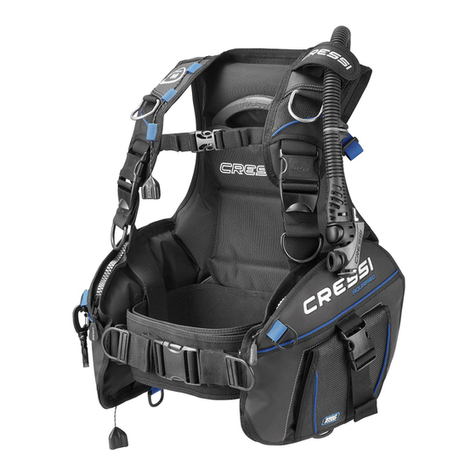
Cressi
Cressi Aquapro Manual
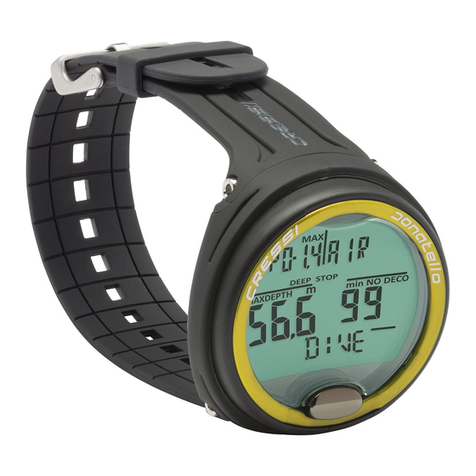
Cressi
Cressi DONATELLO User manual

Cressi
Cressi PORTER User manual

Cressi
Cressi EDY User manual

Cressi
Cressi MC9 S.C. Manual
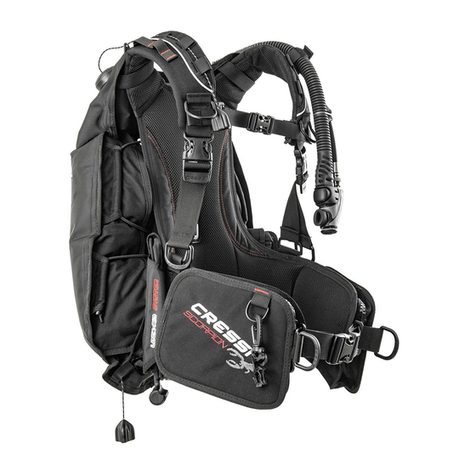
Cressi
Cressi Scorpion Manual
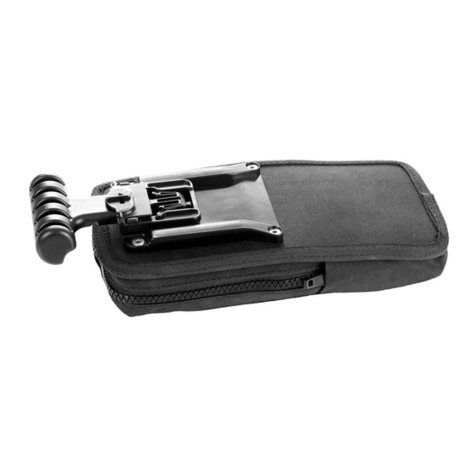
Cressi
Cressi IZ750094 User manual

Cressi
Cressi AQUAWING Manual

Cressi
Cressi Leonardo Manual

Cressi
Cressi CARTESIO GOA User manual
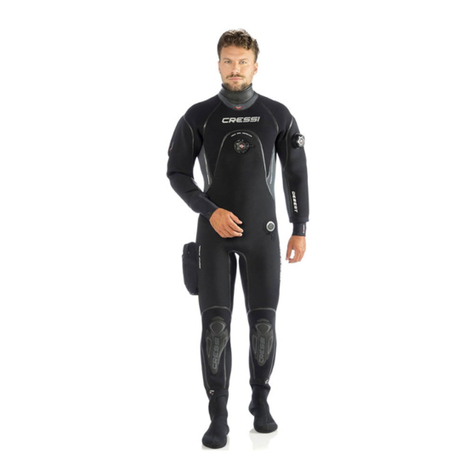
Cressi
Cressi DESERT Manual

Cressi
Cressi Leonardo Manual

Cressi
Cressi NEWTON Reference guide

Cressi
Cressi CARTESIO GOA User manual
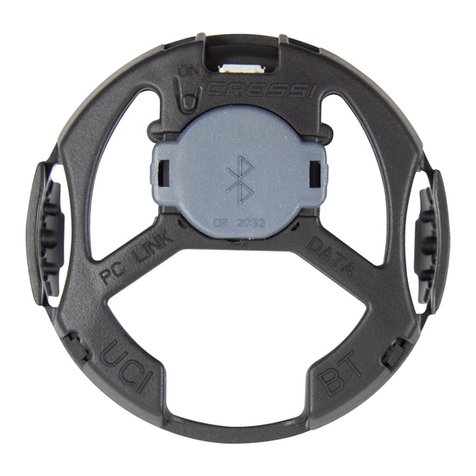
Cressi
Cressi BT Interface User manual

Cressi
Cressi GIOTTO User manual
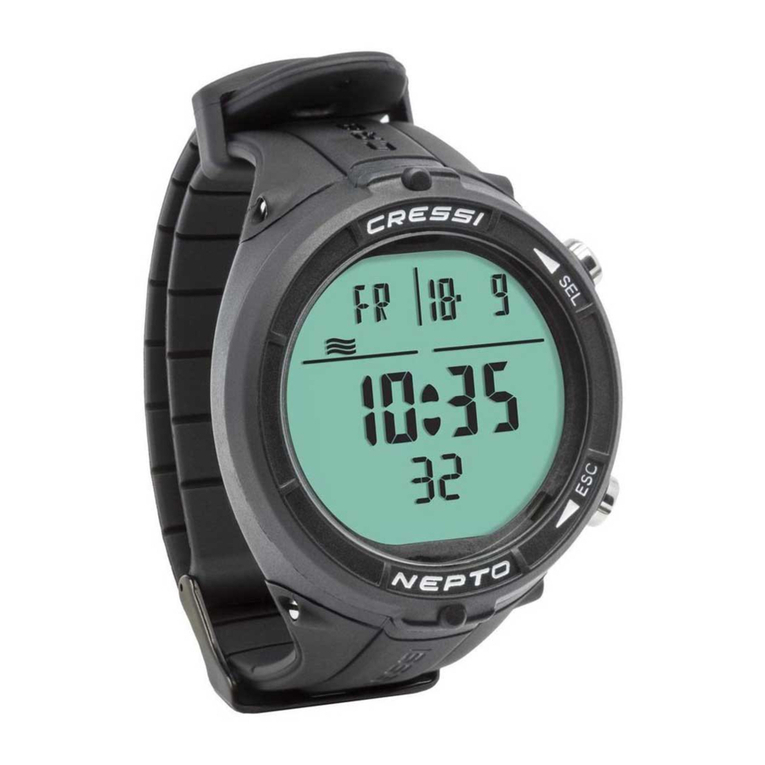
Cressi
Cressi NEPTO User manual
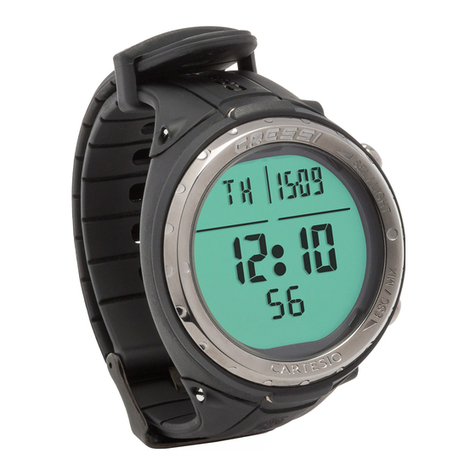
Cressi
Cressi CARTESIO User manual
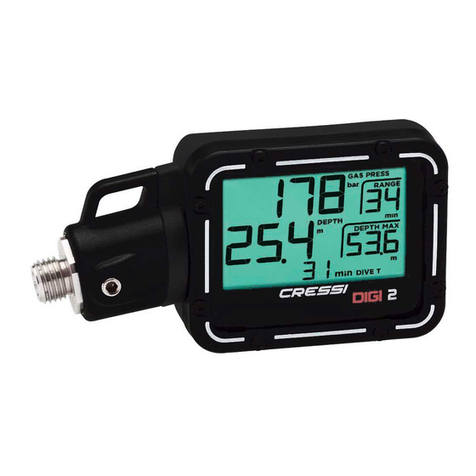
Cressi
Cressi DIGI 2 User manual

Cressi
Cressi DIGI 2 User manual

